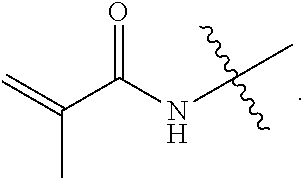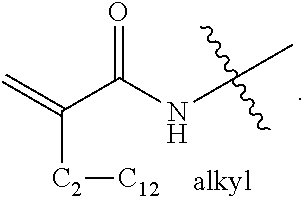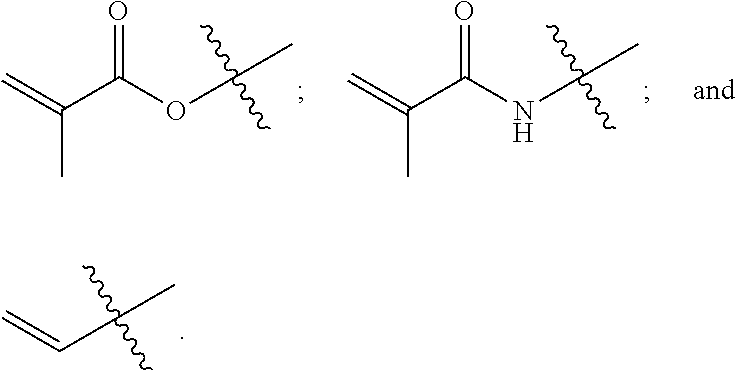Cation-exchange polymer and methods of production
- Summary
- Abstract
- Description
- Claims
- Application Information
AI Technical Summary
Benefits of technology
Problems solved by technology
Method used
Image
Examples
examples — summary
Examples—Summary
[0049]Specific examples are discussed in greater detail below. Table 1 is a summary of the reagents and amounts used in the discussed examples. GMA=glycidyl methacrylate; DMAPMA=N-[3-(dimethylamino)propyl]methacrylamide; DMAEMA=2-(dimethylamino)ethyl methacrylate; VBC=4-vinylbenzyl chloride; AMPS=2-acrylamido-2-methyl-1-propanesulfonic acid; and SSS=sodium 4-vinylbenzenesulfonate. “AMPS 1” and “SSS 1” refer to the AMPS and SSS compounds used as counter ions to the quaternary ammonium. “AMPS 2” and “SSS 2” refer to the AMPS and SSS compounds used as the source of excess anionic charges. In all of the examples, the total amount of anionic monomer present in a polymerization mixture is the sum of AMPS1 and AMPS2, or of SSS1 and SSS2.
TABLE 1H2OGMADMAPMAAMPS 1AMPS 2VA-044TheoreticalExample(g)(g)(g)(g)(g)(g)IEC (meq / g)1508.5310.212.518.811.8220.44.35.16.37.111.5318.24.35.16.35.311.2H2OGMADMAPMAAMPS 1AMPS 2V-50(g)(g)(g)(g)(g)(g)418.24.35.16.35.311.2518.24.35.16.35.311.2H2OG...
example 1
[0050]Water (50 g) was added to a flask. DMAPMA (10.2 g) was added to the water with stirring. Hydrochloric acid (3.3 g of 33% HCl) was slowly added, maintaining the temperature below 60° C. using a water bath. GMA (8.53 g) was added to the solution and the temperature of the water bath was raised to about 55° C. The reaction was allowed to stir for about 1 hour, resulting in a crosslinker having a quaternary amine group of the following structure:
[0051]AMPS (12.5 g) was added to the solution, resulting in a crosslinker according to the present disclosure. This AMPS is identified as “AMPS 1” in Table 1. Additional AMPS (18.8 g) was added and allowed to dissolve. This additional AMPS is identified as “AMPS 2” in Table 1.
[0052]The resulting mixture was allowed to cool to room temperature. VA-044 (1 g) was added as a polymerizing initiator. The mixture was cast on a backing to result in a membrane having thickness of about 0.6 mm, and cured in an oven at 80-90° C.
[0053]The resulting me...
example 2
[0054]Water (20.4 g) was added to a flask. DMAPMA (5.1 g) was added to the water with stirring. Hydrochloric acid (3.3 g of 33% HCl) was slowly added, maintaining the temperature below 60° C. using a water bath. GMA (4.3 g) was added to the solution and the temperature of the water bath was raised to about 55° C. The reaction was allowed to stir for about 1 hour, resulting in a crosslinker having a quaternary amine group of the following structure:
[0055]AMPS (6.3 g) was added to the solution, resulting in a crosslinker according to the present disclosure. This AMPS is identified as “AMPS 1” in Table 1. Additional AMPS (7.1 g) was added and allowed to dissolve. This additional AMPS is identified as “AMPS 2” in Table 1.
[0056]The resulting mixture was allowed to cool to room temperature. VA-044 (1 g) was added as a polymerizing initiator. The mixture was cast on a backing to result in a membrane having thickness of about 0.6 mm, and cured in an oven at 80-90° C.
[0057]The resulting memb...
PUM
| Property | Measurement | Unit |
|---|---|---|
| Fraction | aaaaa | aaaaa |
| Fraction | aaaaa | aaaaa |
| Fraction | aaaaa | aaaaa |
Abstract
Description
Claims
Application Information
 Login to View More
Login to View More - R&D
- Intellectual Property
- Life Sciences
- Materials
- Tech Scout
- Unparalleled Data Quality
- Higher Quality Content
- 60% Fewer Hallucinations
Browse by: Latest US Patents, China's latest patents, Technical Efficacy Thesaurus, Application Domain, Technology Topic, Popular Technical Reports.
© 2025 PatSnap. All rights reserved.Legal|Privacy policy|Modern Slavery Act Transparency Statement|Sitemap|About US| Contact US: help@patsnap.com



